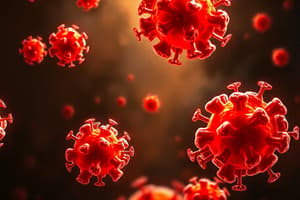Podcast
Questions and Answers
Which of the following represents the most accurate depiction of B cell localization for antigen sampling?
Which of the following represents the most accurate depiction of B cell localization for antigen sampling?
- B cells are uniformly distributed throughout all bodily tissues, engaging in antigen capture and initiating immune responses at the site of infection.
- B cells primarily reside in the bone marrow, intercepting antigens that have directly entered the bloodstream during early development.
- B cell follicles within lymph nodes and the spleen serve as key sites for initial interactions with antigens derived from infected tissues, while marginal zone B cells in the spleen monitor blood antigens. (correct)
- B cells are predominantly found within the thymic medulla, actively surveying self-antigens to prevent autoimmunity.
Considering the signaling requirements for B cell activation, which statement accurately reflects the current understanding of T-independent and T-dependent responses?
Considering the signaling requirements for B cell activation, which statement accurately reflects the current understanding of T-independent and T-dependent responses?
- Both T-independent and T-dependent responses initiate identically, diverging only in their capacity to induce memory B cell formation, which is exclusively a feature of T-independent activation.
- T-independent responses necessitate direct interaction with cognate T cells presenting antigen via MHC-II, ensuring high-affinity antibody production through somatic hypermutation.
- T-independent responses rely on repetitive antigen structures or TLR stimulation, leading primarily to unmutated, low-affinity IgM, while T-dependent responses can involve both early and late responses with potential for somatic hypermutation and class-switching. (correct)
- T-dependent responses are characterized by early IgM production, lacking somatic hypermutation, and relying exclusively on pathogen-associated molecular patterns (PAMPs) for activation.
Which molecular event is most critical when initiating the intracellular signaling cascade following B cell receptor (BCR) engagement?
Which molecular event is most critical when initiating the intracellular signaling cascade following B cell receptor (BCR) engagement?
- Internalization of the BCR-antigen complex into early endosomes followed by immediate degradation to prevent excessive signaling.
- Phosphorylation of Igα/Igβ ITAMs by tyrosine kinases such as SYK, enabling recruitment and activation of downstream signaling molecules. (correct)
- Immediate translocation of the BCR complex to the nucleus to directly influence gene transcription.
- Direct activation of NF-κB through conformational changes in the BCR complex, bypassing proximal kinases.
How do B cells strategically patrol for antigens?
How do B cells strategically patrol for antigens?
Regarding the cellular pathways of B cell activation, what outcome is associated with NF-κB activation downstream of antigen-induced signaling, CD40L, and TLR signaling?
Regarding the cellular pathways of B cell activation, what outcome is associated with NF-κB activation downstream of antigen-induced signaling, CD40L, and TLR signaling?
Marginal zone B cells and B-1 cells both arise from the same developmental pathway and exhibit identical antigen receptor repertoires, primarily targeting polysaccharide antigens in the bloodstream.
Marginal zone B cells and B-1 cells both arise from the same developmental pathway and exhibit identical antigen receptor repertoires, primarily targeting polysaccharide antigens in the bloodstream.
The B cell receptor (BCR) functions exclusively as a signaling receptor, initiating intracellular cascades upon antigen binding, but lacks any role in antigen internalization or presentation to T cells.
The B cell receptor (BCR) functions exclusively as a signaling receptor, initiating intracellular cascades upon antigen binding, but lacks any role in antigen internalization or presentation to T cells.
Describe the critical distinction in signaling pathways between tonic BCR signaling and antigen-induced BCR signaling, focusing on the differential activation of downstream transcription factors and their ultimate impact on B cell fate.
Describe the critical distinction in signaling pathways between tonic BCR signaling and antigen-induced BCR signaling, focusing on the differential activation of downstream transcription factors and their ultimate impact on B cell fate.
Explain how the spatial organization of B cell follicles within secondary lymphoid organs facilitates efficient antigen capture and presentation, detailing the roles of follicular dendritic cells (FDCs) and subcapsular sinus macrophages in this process.
Explain how the spatial organization of B cell follicles within secondary lymphoid organs facilitates efficient antigen capture and presentation, detailing the roles of follicular dendritic cells (FDCs) and subcapsular sinus macrophages in this process.
Delineate the specific roles of the SYK and PI3K kinases in B cell receptor (BCR) signaling, contrasting their immediate substrates and downstream effects on B cell activation and survival.
Delineate the specific roles of the SYK and PI3K kinases in B cell receptor (BCR) signaling, contrasting their immediate substrates and downstream effects on B cell activation and survival.
B cell activation necessitates two signals: engagement of the BCR by antigen, and either T cell help via the ___________ interaction or signals through _________. These signals dictate proliferation, cytokine secretion and differentiation.
B cell activation necessitates two signals: engagement of the BCR by antigen, and either T cell help via the ___________ interaction or signals through _________. These signals dictate proliferation, cytokine secretion and differentiation.
Upon B cell activation, the cellular pathway involving PI3K is essential for B cell __________, whereas the combined signaling via NF-kB and MAPK pathways typically drives ___________ and proliferation.
Upon B cell activation, the cellular pathway involving PI3K is essential for B cell __________, whereas the combined signaling via NF-kB and MAPK pathways typically drives ___________ and proliferation.
Match the following B cell types with their functions:
Match the following B cell types with their functions:
Match the following signaling molecules with their corresponding functions in B cell activation:
Match the following signaling molecules with their corresponding functions in B cell activation:
How does the B cell receptor (BCR) facilitate antigen presentation?
How does the B cell receptor (BCR) facilitate antigen presentation?
What is the predominant isotype produced during T-independent B cell responses?
What is the predominant isotype produced during T-independent B cell responses?
Follicular dendritic cells (FDCs) directly stimulate B cells through cognate peptide-MHC interactions, providing a critical signal for B cell activation within germinal centers.
Follicular dendritic cells (FDCs) directly stimulate B cells through cognate peptide-MHC interactions, providing a critical signal for B cell activation within germinal centers.
Contrast the roles of early and late signaling events following B cell receptor (BCR) ligation in determining B cell fate decisions, focusing on the activation of specific transcription factors and their downstream effects on proliferation, differentiation, and survival.
Contrast the roles of early and late signaling events following B cell receptor (BCR) ligation in determining B cell fate decisions, focusing on the activation of specific transcription factors and their downstream effects on proliferation, differentiation, and survival.
The germinal center reaction critically relies on the enzyme ___________, which introduces somatic hypermutations into the immunoglobulin genes, ultimately driving affinity maturation of the B cell response.
The germinal center reaction critically relies on the enzyme ___________, which introduces somatic hypermutations into the immunoglobulin genes, ultimately driving affinity maturation of the B cell response.
Which of the following outcomes is most directly associated with the ability of B cells to present antigen to T helper cells?
Which of the following outcomes is most directly associated with the ability of B cells to present antigen to T helper cells?
Flashcards
B cell follicles
B cell follicles
Areas in lymph nodes and spleen where B cells interact with antigens.
B cell activation requirements
B cell activation requirements
Requires antigen binding to the BCR and either T cell help OR signals through TLRs.
T-independent responses
T-independent responses
Early response antibody, low affinity, and is mostly IgM.
B cell activation summary
B cell activation summary
Signup and view all the flashcards
B cell patrolling
B cell patrolling
Signup and view all the flashcards
T-dependent responses
T-dependent responses
Signup and view all the flashcards
Memory B cells
Memory B cells
Signup and view all the flashcards
B cell functions
B cell functions
Signup and view all the flashcards
Study Notes
B Cells and Antibodies
- B cell activation involves B cells encountering and responding to their specific antigens
B Cell Localization and Antigen Sampling
- After development, B cells circulate in secondary lymphoid organs like the lymph nodes, spleen, tonsils, and Peyer's patches to encounter antigens
- B cell follicles in lymph nodes (LN) and the spleen are primary sites for interactions with antigens coming from infected tissues
- Marginal zone B cells in the spleen monitor antigens present in the blood
Activation Signals
- Activation requires two signals: antigen binding to the B cell receptor (BCR) and a second signal, provided either by T cell help or through pathogen-associated molecular patterns (PAMPs) binding to Toll-like receptors (TLRs)
T cell independent response
- Early response to infection
- Involves unmutated (low affinity) antibodies, primarily IgM
T cell dependent response
- Involves both early and late responses
- Can involve unmutated (low affinity) IgM, but also somatically mutated (high affinity) IgG
Summary of B Cell Activation
- B cells strategically patrol areas draining antigens from tissues
- B cell activation requires two signals: antigen binding to the BCR and either T cell help or signals through TLRs
- The BCR serves as both a signaling receptor and an endocytic receptor for antigen presentation
- B cell activation leads to proliferation, cytokine secretion, and differentiation into germinal center B cells, plasma cells (PCs), and memory B cells
Cellular Pathways of B Cell Activation
- Tonic signaling through the BCR sustains B cell survival
- Antigen-induced signaling initiates a cascade involving Syk, NFκB, Ca2+, MAPK, and PI3K, leading to gene transcription and potentially apoptosis or survival
- Additional signals like CD40L from T helper cells and cytokines further drive B cell differentiation and class switching
B Cell Functions
- Antibody production
- Cytokine Secretion: B cells secrete both pro-inflammatory cytokines (IL-6, TNFα, IL-12, INFγ) and regulatory cytokines (IL-10, TGFβ, IL-35)
- Antigen Presentation: B cells can present antigens to T cells, further modulating the immune response
Memory B Cells
- Display characteristics of being long-lived, highly sensitive, class-switched, and PC-biased
- Further defined by having several subsets imprinted from previous activation
Studying That Suits You
Use AI to generate personalized quizzes and flashcards to suit your learning preferences.




